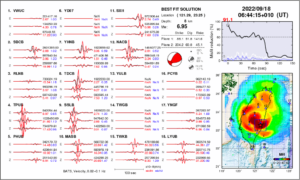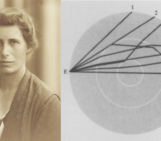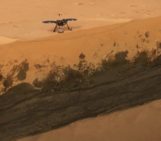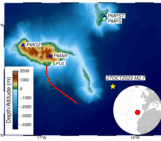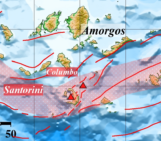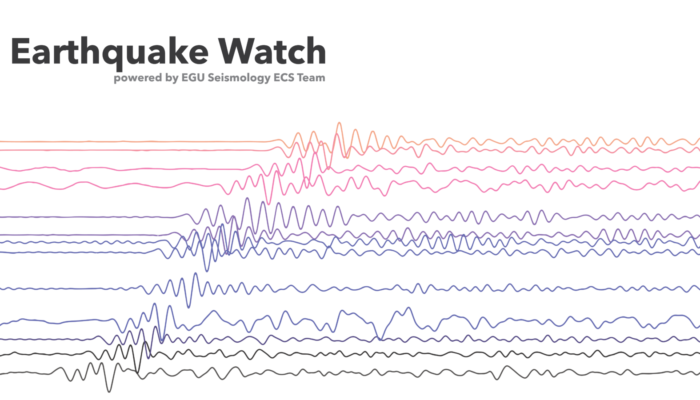
Contribution about the September 2022 M 6.6 and M 6.8 earthquakes in South-East Taiwan Dr.Yifan Yin , recent graduate at the Swiss Seismological Service (SED) at the Earth Sciences department of ETH Zürich.
On 17 September 2022, a magnitude 6.6 quake shook the southern-east Taiwan. The merely 8.6 km deep quake was widely felt across the island. Sixteen hours later, a magnitude 6.8 shallow quake followed, nucleating further north and causing serious damage in the region.
The real-time centroid-moment-tensor solution (RMT) is a service developed by Dr. Shiann-Jong Lee’s group at Academia Sinica that can invert for possible fault plane orientations. The real-time result shows the two quakes are very similar in rupture style, closely located to each other and very shallow (Figure 1) (Lee et al., 2013). Notice the close-by stations are saturated and were not included in the inversion.
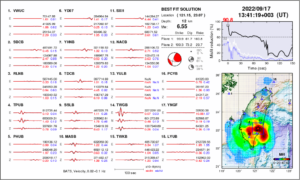
Figure 1. Real-time source mechanism inversion of the two major shocks from the RMT service, Academia Sinica, Taiwan. (Original Link a, b)
The strong shaking is also recorded by the dense P-Alert network composed of MEMS accelerometers across the island operated by the National Taiwan University (Wu et al., 2016). The network is built for early warning of strong shaking, but it also records real-time ground motion. From the distribution of strong shaking, we could already observe a clear elongated rupture of the second earthquake (Figure 2b). The bridges crossing the valley did not take the shaking well, and were the most damaged infrastructures during the earthquake sequence.
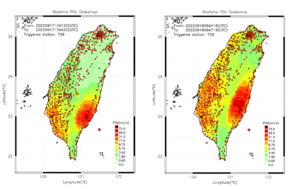
Figure 2 a-b. The real-time peak ground velocity recorded by the P-Alert network. The left panel shows the first shock on 17 Sept. The second panel shows the larger mainshock on 18 September. Plots taken from P-Alert automatic reports.
This news clip from the Taiwan Public Television Service filmed the two collapsed bridges. Six bridges were damaged in total, of which two collapsed entirely. The bridges have to be built perpendicular to the valley to cross rivers. However, they are obviously not ideal to resist the along-valley ruptures.
Other damages include bulged ground, deformed patties and the railway and a collapsed building. Here is a twitter post showing some of these features:
Taiwan is perhaps best known for the mountain-building thrust faults, such as the Chelungpu Fault that ruptured central Taiwan in 1999 (Ma et al., 1999). However, the earthquakes Taiwanese people feel in the daily life mostly occur on the plate boundary: in the two subduction zones to the north and south, and along the suture zone on land that forms the Longitudinal Valley in the east. Geodetic measurements show that the Valley accumulates ~20 mm of vertical and left-lateral movement per year (J. B. H. Shyu et al., 2005). The Longitudinal Valley Fault (LVF) is of the fastest moving faults (>10 mm/year) on land in Taiwan (Shyu et al., 2020).
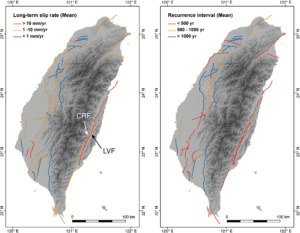
Figure 3. Seismogenic faults in Taiwan for the updated Taiwan earthquake model. Plot modified from (Shyu et al., 2020). LVF: Longitudinal Fault; CRF: Central Range Fault. The left panel shows the mean slip rate. The right panel shows the mean return period.
The Longitudinal Valley Fault is active, exhibiting both seismic and aseismic movement, and is the subject of extensive study (Thomas et al., 2014). The two events this year both occurred on the southern end of the Valley. However, they are not on the well-known LVF that dips to the east. CMT solutions show that the two mainshocks may nucleate on the high-angle, west-dipping Central Range Fault (CRF) (Figure 4). Compared to its neighbor, the CRF appears to be blind in the south and inactive before the last decade (Shyu et al., 2006). Due to the inactivity, the fault is not in the official active faults issued by the Taiwan geological survey.
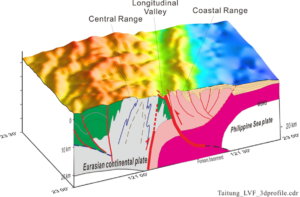
Figure 4. Tectonic profile along the 23-degree latitude, showing the suture zone of two plates and two opposite reverse faults marked by the red lines. The one on the left is the suspected CRF that host the two shocks (plot courtesy of Dr. Jian-Cheng Lee).
During the 2022 sequence, seismicity lit up in the region. Rapid machine-learning detection and relocation results performed by the structural seismology lab at Taiwan University have located 4,257 events in the region (Kuo-Chen et al., 2022). The distribution shows wide activation along CRF to the left of the valley and underneath the mountain ranges. The shocks also likely triggered some part of the LVF (Figure 5).
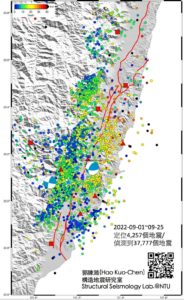
Figure 5. Seismicity in the eastern Taiwan in the month of two mainshocks. Red lines mark the active fault traces. The events are detected using SeisBlue. (Plot courtesy of Prof. Hao Kuo-Chen)
Preceding the sequence this year, there have been several Magnitude-6 quakes along the Valley that occur on west-dipping fault planes since 2013. Figure 6 compiles the significant events since 2013 that consist of similar rupture planes. The 2022 sequence likely illuminated the southern section of the Central Range Fault. The detailed fault geometry is yet to be revealed.
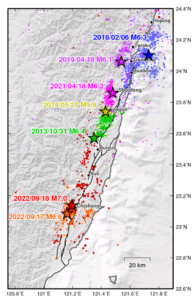
Figure 6. Recent significant event and their aftershocks that shares similar fault plane geometry. The 2018 M6.3 Hualian earthquake is an exception as it involves multiple structures, including the subduction zone. (Plot courtesy of Dr. Shiann-Jong Lee)
If the whole fault shakes loose, what would be the seismogenic potential of the CRF from now on? Are there still sections that are locked and loaded? Can it interact with the fast-slipping LVF? Scientists will be busy solving the puzzles these sequences raise for years to come.
Acknowledgement
This post is done with the help of Prof. Yi-Ing Wen at National Chung Cheng University. The material collected for the events is an effort from the Taiwan Earthquake Research Center and its members.
Reference
Kuo-Chen, H., Sun, W.-F., Huang, C.-M., & Pan, S.-Y. (2022). Near real-time seismic data processing helps scientist understand aftershocks. https://doi.org/10.32858/temblor.276
Shyu, J. B. H., Sieh, K., Chen, Y.-G., & Liu, C.-S. (2005). Neotectonic architecture of Taiwan and its implications for future large earthquakes. Journal of Geophysical Research, [Solid Earth], 110(B8). https://doi.org/10.1029/2004JB003251
This blog post was written by Dr.Yifan Yin, recent graduate at the Swiss Seismological Service (SED) at the Earth Sciences department of ETH Zürich. It was edited by ECS member Katinka Tuinstra.

